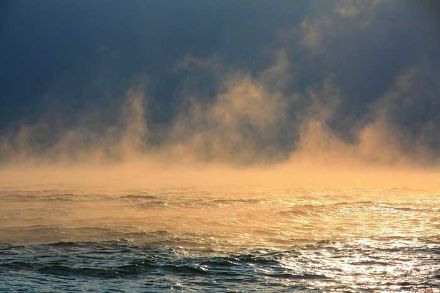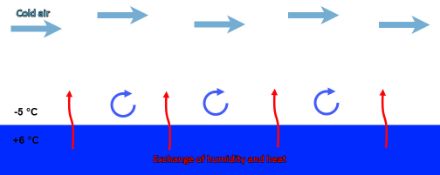Service Navigation
Search

Mechanism behind evaporation fog
Evaporation fog occurs when a somewhat dry, cold or even very cold air mass moves over a relatively mild water surface. The thin layer of air that is in direct contact with the water's surface is heated by it and absorbs water vapour (humidity).As this thin layer mixes with the even colder layer of air above it, the water vapour condenses and evaporation fog forms (fog).
This phenomenon can also occur in another way near the ground, when water from recent rainfall, for example after a summer thunderstorm, evaporates on the warm ground (for example a tarred surface).Athletes can have a similar experience when their sweat-soaked clothes begin to "smoke" in the colder ambient air due to evaporation in winter.
Favourable weather situation for evaporation fog
Evaporation fog occurs when continental sub-polar or continental Arctic air masses move over relatively mild water surfaces. Since the cold air can absorb less moisture than the warm air, the continental (dry) factor is important. It makes it possible for a sufficient amount of water vapour to evaporate and condense to create the "smoke".

In most cases, a temperature difference of at least 10 to 12°C between the water's surface and the air mass is necessary for evaporation fog to occur This unstable profile, driven by the transfer of perceptible and latent heat from the water towards cold and dry air, often gives the "smoke" a turbulent appearance. Over the North Sea or Baltic Sea or on the Atlantic Ocean it may even be accompanied by small, warm thunderstorms, but this is not the case with Swiss lakes.
Evaporation fog usually occurs at the end of autumn or beginning of winter with the inflow of the first really cold air masses, when the lake waters are still relatively warm and not yet frozen. It can occur both in strong winds, such as a Bise current as well as when there is no wind, which distinguishes it from radiation fog, which is formed exclusively when there is little wind.
